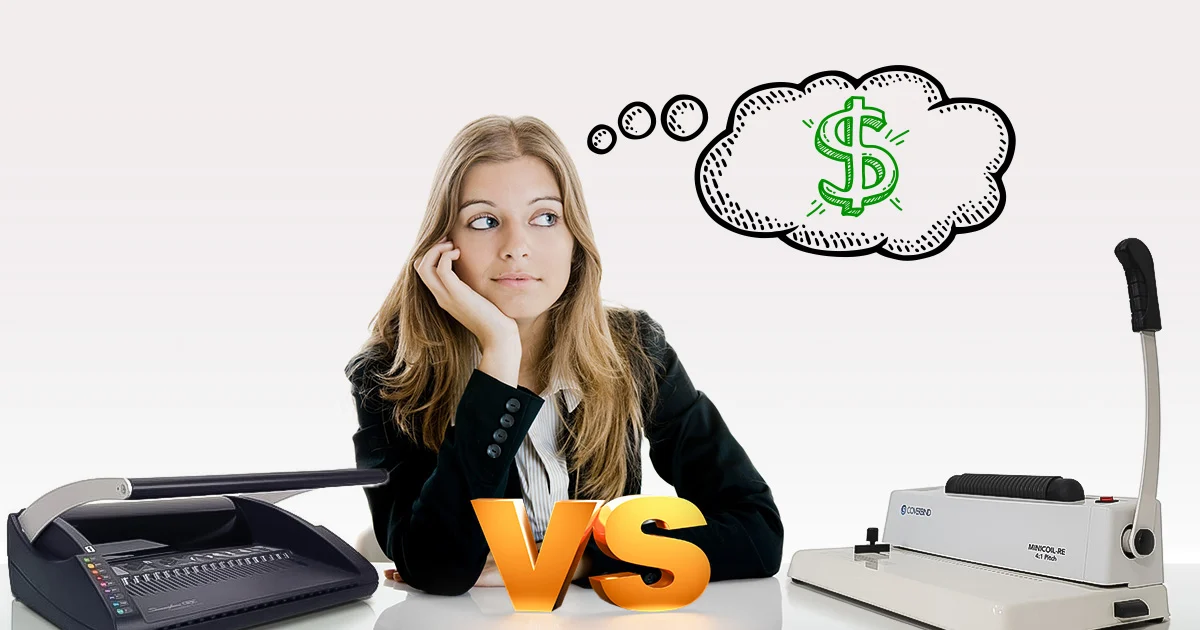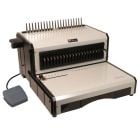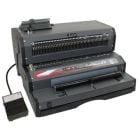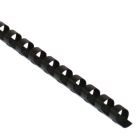Comb Binding versus Spiral Binding-How to Save on your Next Project

Estimated Reading Time
- 3 min
TLDR
Spiral binding and comb are two of the most popular binding methods. Why? One of the biggest selling points is their affordability both upfront and through consumables. This article walks through some of the key differences between the two and how both options can save you money on your next project (plus every other project down the road).
Two of the most popular binding methods on the market remain spiral binding and comb. For decades these traditional binding methods have outshined the competition for many reasons, but one of the biggest is their ability to save you —the end user— money. Not just upfront on your initial purchase, but also down the road through affordable consumables.
But just because they’re affordable doesn’t mean they’re cheap! These quality binding methods don’t disappoint in the finished look or functionality of your bound document. So if you’re looking for the best binding machine to save money, look no further as we explore the two most popular binding options that won’t break the bank.
The Difference between Comb Binding and Coil Binding
Comb binding uses plastic combs to bind documents, giving you a quick and reusable binding solution for various projects. The comb binding machine punches rectangular holes along the edge of the document. Then, you open and thread a plastic comb through the holes to securely bind the pages together, and you’re done!
On the other hand, spiral binding — also known as coil binding — uses a coil binding machine that punches holes along the edge and then spins a continuous coiled piece of plastic that is then crimped on the edges. It creates a durable, professional-looking document that can lay flat or fold back on itself.
Want to know how to use these innovative machines? Check out our video tutorials on how to use a comb binding machine and a spiral binding machine.
Which binding method will save me time?
Both comb and spiral binding methods can save you from being bogged down by time-consuming processes — all while making your documents look amazing.
Visual Appeal
Comb binding provides neat, aligned spines that give your document a polished and organized look. It also allows you to tab each section and easily label the plastic comb spine. It’s perfect for business proposals and other professional documents.
Coil binding’s continuous spiral gives your document a sleek and contemporary feel. You can use it for cookbooks and scrapbooks so every page turns smoothly. It’s functional and adds that special pop of pizzaz to your creation.
Document Functionality
Comb binding lets you quickly add or remove pages by simply opening the comb, making your changes, and closing it back up. Moreover, the flat-laying design makes comb-bound documents a breeze to read and reference.
On the other hand, documents bound with coil can withstand frequent handling, and you can flip pages easily thanks to the 360-degree turn capability. Granted, the initial binding may take a bit longer than comb binding. But the longevity and user-friendliness can offset the time spent upfront.
Binding Capacity
Comb and coil binding both offer impressive binding capacities to handle a huge variety of books. Comb binding can bind documents ranging from just a few pages up to a whopping 425 sheets while coil binding typically caters to documents of up to 300 sheets.
Which binding method will last longer?
Both comb and coil binding have their merits in terms of durability and longevity, but one truly passes the test of time.
Durability
Comb-bound documents are sturdy thanks to the resilient plastic combs that can stand a fair amount of wear and tear. However, they might not fare as well under extreme conditions or with rough handling.
Conversely, spiral-bound documents offer flexibility and strength as the coils actually bounce back when bent. Coil is a popular choice for schools, cookbooks, manuals, menus, and other heavily-handled documents.
Expected Lifespan
When used under normal conditions with proper care, comb-bound documents can last for several years. However, the plastic combs might become brittle over time, especially when exposed to direct sunlight or extreme temperatures.
Spiral-bound documents are built to last. The plastic coils can retain their shape and functionality with minimal care, so they outlast many other binding methods, including comb binding.
Which binding machine is more affordable?
Comb binding machines are typically cheaper than spiral binding machines, but you can get a low-volume model of both for a fairly low price. The best coil binding machine to save money has to be either the RubiCoil or MiniCoil, both very popular machines with great customer feedback.
Comb binding machine prices start a bit lower with the Fellowes Pulsar+ 300 being one of the more popular low-volume models we have. But we even have a Pfeiffer comb machine with starter kit for less than a couple of large pizzas.
Which binding method will cost less after I buy supplies?
Since comb binding machines can be so much cheaper, they may still cost less than a spiral binding machine even after you buy supplies.
Some necessary plastic comb binding supplies include:
- Plastic combs
- Binding covers
- Index tabs
On the other hand, some key spiral coil binding supplies are:
- Plastic or metal spiral coils
- Crimpers
- Punched paper
- Punched covers
- Binding sleeves and sticks
What are some practical tips to help save on my project?
Whether you choose coil or comb binding, here are some tips to help you get the most bang for your buck.
How to choose your method
The key to a successful binding project lies in choosing the method that aligns with your specific requirements. If you’re working on a one-time presentation or a report that doesn’t require frequent updates, comb binding might be your best fit. But if you’re looking for something more durable for documents that’ll see a lot of handling (like training manuals or cookbooks), spiral binding is the way to go.
How to get the most out of your machine
There are several ways to optimize your budget and achieve the best results:
- Complete regular maintenance
- Don’t overload the machine
- Buy supplies in bulk
- Always use the correct document size
Is Coil or Comb binding better for my Budget?
Both comb binding and spiral binding have their unique strengths. Comb binding offers flexibility and polish because it’s so easy to edit. Spiral binding provides longevity and a professional finish thanks to its durable coil that is actually flexible. But which one takes the crown when comparing coil versus comb binding cost?
If we’re just talking dollars, comb is the way to go. Comb binding is the cheapest way to bind pages with a traditional punch-and-bind method. But if we’re talking value, then the answer isn’t one size fits all. Comb is great for frequent editing while spiral coil is best for durability. They each offer different value that will simply depend on your organization’s priorities.
In the end, the best choice aligns with your project’s specific needs and your budget. So, weigh the pros and cons of each machine and make an informed decision that suits your project goals and wallet.
Are you ready to find your perfect binding machine?
Give us a call at 1-800-944-4573 we’d be happy to assist you.









